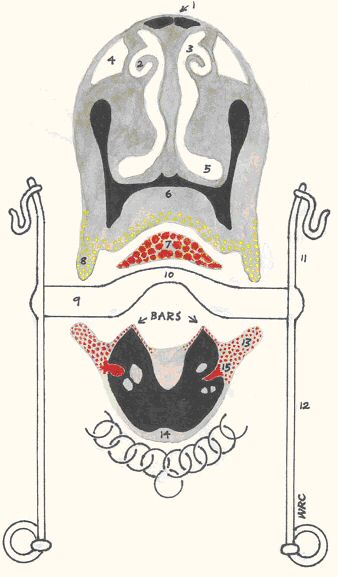The Bitless Bridle™ in UK
Fear of the Bit: A welfare problem for horse and rider
W. Robert Cook FRCVS, PhD
Diagram of Horse's Head showing Position of Bit
- Black = bone
- Gray = soft tissue
- Red = areas of special sensitivity supplied by terminal branches of the mandibular nerve
- Yellow = areas of special sensitivity supplied by terminal branches of the maxillary nerve
- peak of the nasal bone (with which the noseband of the Bitless Bridle is in contact) - 1
- ventral turbinate bone - 2
- entrance to the middle meatus (a passage that connects with the sinuses) - 3
- false nostril (this space becomes eliminated when the nostrils dilate at exercise) - 4
- ventral meatus (the major nasal airway) - 5
- hard palate (contacted by high ports and spade bits) - 6
- the tip or free portion of the tongue (continuous with the body and root of the tongue) - 7
- upper lip - 8
- cannon - 9
- port - 10
- cheek bar - 11
- shank - 12
- lower lip - 13
- chin groove (so-named because it is the line of skin under the body of the mandible with which the curb chain comes in contact but it is not really a ‘groove’) - 14
- mental foramen, the point at which the mandibular nerve emerges from the jaw to supply sensation to the bars of the mouth and the lower lip - 15
Copyright © 2004-2025 Bitless Bridle UK All Rights Reserved | The Bitless Bridle™ is protected by US patent 6591589
Website designed, maintained and hosted by Flashgranny

